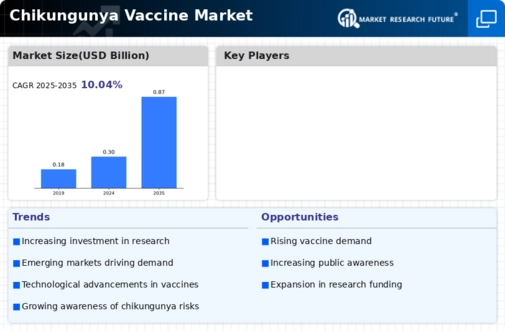Market Share
Chikungunya Vaccine Market Share Analysis
Chikungunya is a viral illness caused by the Chikungunya virus (CHIKV) and transmitted to humans through bites from infected mosquitoes, with Aedes albopictus and Aedes aegypti being the primary culprits in spreading the disease. As of August 2022, the European Centre for Disease Prevention and Control has reported 229,029 cases and 41 deaths globally due to chikungunya. Brazil has seen a significant number of chikungunya cases, leading the tally in 2022 until August.
The World Health Organization (WHO) notes that chikungunya fever has been documented in over 60 countries across Africa, Asia, Europe, and the Americas since 2004. The year 2015 witnessed widespread outbreaks in several countries in the Americas. The WHO underscores a higher prevalence of chikungunya in regions such as Asia, Africa, and the Indian subcontinent. The escalating instances of chikungunya across various parts of the world have heightened the demand for chikungunya vaccines, consequently propelling the expansion of the global chikungunya vaccine market.
Chikungunya is a viral disease characterized by symptoms such as fever, joint pain, headache, and muscle pain. In some cases, individuals may experience persistent joint pain for an extended period. The disease is primarily transmitted by mosquitoes, and its impact on affected individuals and communities has spurred the development of vaccines to prevent its spread.
The chikungunya vaccine market offers various types of vaccines, including live-attenuated virus vaccines, inactivated viral vaccines, recombinant viral vaccines, chimeric-alphavirus candidates, and others. These vaccines aim to provide effective and safe preventive measures against chikungunya, catering to the diverse needs and preferences within the medical community.
Governments and health organizations globally are increasingly recognizing the urgency of addressing mosquito-borne diseases, including chikungunya. Initiatives involving public awareness campaigns, mosquito control programs, and community engagement are being implemented to mitigate the impact of these diseases. The emphasis on prevention and control aligns with the overarching goal of safeguarding public health and reducing the transmission of chikungunya.
However, the journey to combat chikungunya is not without its challenges. The development and approval of vaccines entail adherence to strict regulatory requirements, necessitating rigorous testing and compliance to ensure safety and efficacy. These regulatory hurdles can pose obstacles for companies looking to introduce new vaccines to the market. Overcoming these challenges requires significant investments in research, development, and clinical trials.
Despite the regulatory challenges, there are substantial growth opportunities in the chikungunya vaccine market. Developing and underdeveloped countries, which often bear a disproportionate burden of mosquito-borne diseases, present promising prospects for market expansion. The rising unmet needs for effective treatments and preventive measures in these regions create a compelling market opportunity.
The global chikungunya vaccine market is witnessing growth driven by the increasing prevalence of chikungunya across different regions. Governments and health organizations are actively engaged in initiatives to prevent and control mosquito-borne diseases. While stringent regulatory requirements pose challenges for market players, there are significant opportunities in developing and underdeveloped countries with high unmet needs. The ongoing research and development efforts in the chikungunya vaccine market signify a commitment to addressing a pressing global health concern and improving public health outcomes.




Leave a Comment